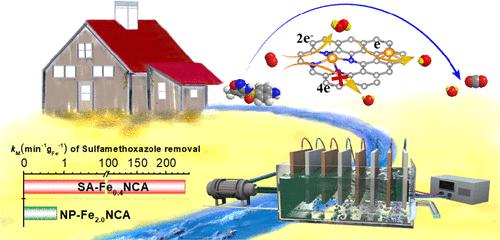当前位置:
X-MOL 学术
›
Environ. Sci. Technol.
›
论文详情
Our official English website, www.x-mol.net, welcomes your
feedback! (Note: you will need to create a separate account there.)
Electronic Control of Traditional Iron–Carbon Electrodes to Regulate the Oxygen Reduction Route to Scale Up Water Purification
Environmental Science & Technology ( IF 10.8 ) Pub Date : 2022-09-21 , DOI: 10.1021/acs.est.2c03673 Zining Wang 1 , Fan Xiao 1 , Xuqian Shen 1 , Di Zhang 2 , Wenhai Chu 2 , Hongying Zhao 1 , Guohua Zhao 1
Environmental Science & Technology ( IF 10.8 ) Pub Date : 2022-09-21 , DOI: 10.1021/acs.est.2c03673 Zining Wang 1 , Fan Xiao 1 , Xuqian Shen 1 , Di Zhang 2 , Wenhai Chu 2 , Hongying Zhao 1 , Guohua Zhao 1
Affiliation

|
Shifting four-electron (4e–) oxygen reduction in fuel cell technology to a two-electron (2e–) pathway with traditional iron–carbon electrodes is a critical step for hydroxyl radical (HO•) generation. Here, we fabricated iron–carbon aerogels with desired dimensions (e.g., 40 cm × 40 cm) as working electrodes containing atomic Fe sites and Fe3C subnanoclusters. Electron-donating Fe3C provides electrons to FeN4 through long-range activation for achieving the ideal electronic configuration, thereby optimizing the binding energy of the *OOH intermediate. With an iron–carbon aerogel benefiting from finely tuned electronic density, the selectivity of 2e– oxygen reduction increased from 10 to 90%. The resultant electrode exhibited unexpectedly efficient HO• production and fast elimination of organics. Notably, the kinetic constant kM for sulfamethoxazole (SMX) removal is 60 times higher than that in a traditional iron–carbon electrode. A flow-through pilot device with the iron–carbon aerogel (SA-Fe0.4NCA) was built to scale up micropolluted water decontamination. The initial total organic carbon (TOC) value of micropolluted water was 4.02 mg L–1, and it declined and maintained at 2.14 mg L–1, meeting the standards for drinking water quality in China. Meanwhile, the generation of emerging aromatic nitrogenous disinfection byproducts (chlorophenylacetonitriles) declined by 99.2%, satisfying the public safety of domestic water. This work provides guidance for developing electrochemical technologies to satisfy the flexible and economic demand for water purification, especially in water-scarce areas.
中文翻译:

传统铁碳电极的电子控制调节氧还原路线以扩大水净化
将燃料电池技术中的四电子 (4e – ) 氧还原转变为使用传统铁碳电极的两电子 (2e – ) 途径是羟基自由基 (H2O • ) 生成的关键步骤。在这里,我们制造了具有所需尺寸(例如,40 cm × 40 cm)的铁碳气凝胶作为含有原子 Fe 位点和 Fe 3 C 亚纳米团簇的工作电极。给电子Fe 3 C通过长程活化为FeN 4提供电子以实现理想的电子构型,从而优化*OOH中间体的结合能。得益于微调电子密度的铁碳气凝胶,2e 的选择性-氧气减少量从 10% 增加到 90%。所得电极表现出出乎意料的高效H2O •产生和有机物的快速消除。值得注意的是,磺胺甲恶唑 (SMX) 去除的动力学常数k M是传统铁碳电极的 60 倍。建造了一个带有铁碳气凝胶(SA-Fe 0.4 NCA)的流通式试验装置,以扩大微污染水的净化。微污染水体总有机碳(TOC)初始值为4.02 mg L -1,随后下降并维持在2.14 mg L -1,符合中国饮用水水质标准。同时,新出现的芳香族含氮消毒副产物(氯苯乙腈)的产生量下降了99.2%,满足了生活用水的公共安全。这项工作为开发电化学技术以满足灵活和经济的水净化需求提供了指导,特别是在缺水地区。
更新日期:2022-09-21
中文翻译:

传统铁碳电极的电子控制调节氧还原路线以扩大水净化
将燃料电池技术中的四电子 (4e – ) 氧还原转变为使用传统铁碳电极的两电子 (2e – ) 途径是羟基自由基 (H2O • ) 生成的关键步骤。在这里,我们制造了具有所需尺寸(例如,40 cm × 40 cm)的铁碳气凝胶作为含有原子 Fe 位点和 Fe 3 C 亚纳米团簇的工作电极。给电子Fe 3 C通过长程活化为FeN 4提供电子以实现理想的电子构型,从而优化*OOH中间体的结合能。得益于微调电子密度的铁碳气凝胶,2e 的选择性-氧气减少量从 10% 增加到 90%。所得电极表现出出乎意料的高效H2O •产生和有机物的快速消除。值得注意的是,磺胺甲恶唑 (SMX) 去除的动力学常数k M是传统铁碳电极的 60 倍。建造了一个带有铁碳气凝胶(SA-Fe 0.4 NCA)的流通式试验装置,以扩大微污染水的净化。微污染水体总有机碳(TOC)初始值为4.02 mg L -1,随后下降并维持在2.14 mg L -1,符合中国饮用水水质标准。同时,新出现的芳香族含氮消毒副产物(氯苯乙腈)的产生量下降了99.2%,满足了生活用水的公共安全。这项工作为开发电化学技术以满足灵活和经济的水净化需求提供了指导,特别是在缺水地区。











































 京公网安备 11010802027423号
京公网安备 11010802027423号